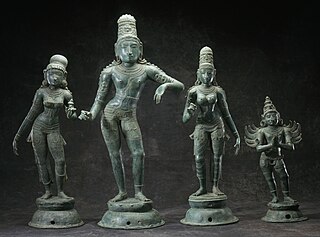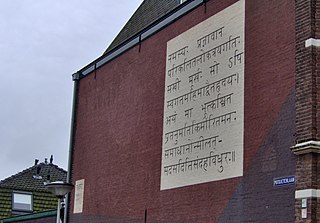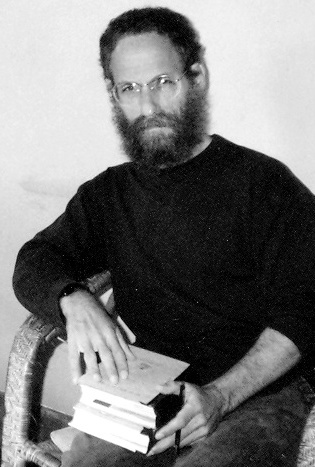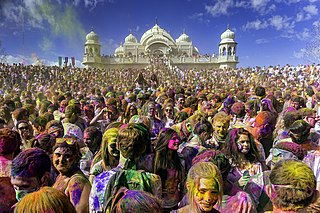Hinduism is an Indian religion or dharma, a religious and universal order by which its followers abide. The word Hindu is an exonym, and while Hinduism has been called the oldest religion in the world, it has also been described as sanātana dharma, a modern usage, based on the belief that its origins lie beyond human history, as revealed in the Hindu texts. Another endonym for Hinduism is Vaidika dharma.

Yoni, sometimes called pindika, is an abstract or aniconic representation of the Hindu goddess Shakti. It is usually shown with linga – its masculine counterpart. Together, they symbolize the merging of microcosmos and macrocosmos, the divine eternal process of creation and regeneration, and the union of the feminine and the masculine that recreates all of existence. The yoni is conceptualized as nature's gateway of all births, particularly in the esoteric Kaula and Tantra practices, as well as the Shaktism and Shaivism traditions of Hinduism.
Indian culture is the heritage of social norms and technologies that originated in or are associated with the ethno-linguistically diverse India, pertaining to the Indian subcontinent until 1947 and the Republic of India post-1947. The term also applies beyond India to countries and cultures whose histories are strongly connected to India by immigration, colonisation, or influence, particularly in South Asia and Southeast Asia. India's languages, religions, dance, music, architecture, food, and customs differ from place to place within the country.

Hinduism in Southeast Asia had a profound impact on the region's cultural development and its history. As the Indic scripts were introduced from the Indian subcontinent, people of Southeast Asia entered the historical period by producing their earliest inscriptions around the 1st to 5th century CE. Today, Hindus in Southeast Asia are mainly Overseas Indians and Balinese. There are also Javanese and Balamon Cham minority in Cambodia and south central Vietnam who also practice Hinduism.
Indology, also known as South Asian studies, is the academic study of the history and cultures, languages, and literature of the Indian subcontinent, and as such is a subset of Asian studies.

Hinduism is a minority religion in Cambodia which is followed by about 1,000 to 15,000 individuals. Even being a small minority in the Buddhist majority nation it highly influences the vast culture and history of Cambodia with being prominent religion under the Khmer Empire. Today most of the Cambodian Hindus are Indians in Cambodia. Cambodia had always been a Buddhist nation since its conception, but before its independence from French Indochina, it had a significant Hindu minority, and several hundred years before that, it had been the most dominant religion in Cambodia as well as Southeast Asia.

Greater India, also known as the Indian cultural sphere, or the Indic world, is an area composed of many countries and regions in South Asia, East Asia and Southeast Asia that were historically influenced by Indian culture, which itself formed from the various distinct indigenous cultures of these regions. The term Greater India, as a reference to the Indian cultural sphere, was popularised by a network of Bengali scholars in the 1920s. It is an umbrella term encompassing the Indian subcontinent and surrounding countries, which are culturally linked through a diverse cultural cline. These countries have been transformed to varying degrees by the acceptance and introduction of cultural and institutional elements from each other. Since around 500 BCE, Asia's expanding land and maritime trade had resulted in prolonged socio-economic and cultural stimulation and diffusion of Buddhist and Hindu beliefs into the region's cosmology, in particular in Southeast Asia and Sri Lanka. In Central Asia, the transmission of ideas was predominantly of a religious nature.

The history of Hinduism covers a wide variety of related religious traditions native to the Indian subcontinent. It overlaps or coincides with the development of religion in the Indian subcontinent since the Iron Age, with some of its traditions tracing back to prehistoric religions such as those of the Bronze Age Indus Valley Civilisation. Hinduism has been called the "oldest religion" in the world, but scholars regard Hinduism as a relatively recent synthesis of various Indian cultures and traditions, with diverse roots and no single founder. This Hindu synthesis emerged after the Vedic period, between c. 500-200 BCE and c. 300 CE, in or after the period of the Second Urbanisation, and during the early classical period of Hinduism. It flourished in the medieval period, with the decline of Buddhism in India.

Sanskrit has been studied by Western scholars since the late 18th century. In the 19th century, Sanskrit studies played a crucial role in the development of the field of comparative linguistics of the Indo-European languages. During the British Raj (1857–1947), Western scholars edited many Sanskrit texts which had survived in manuscript form. The study of Sanskrit grammar and philology remains important both in the field of Indology and of Indo-European studies.

Moriz Winternitz was a scholar from Austria who began his Indology contributions working with Max Müller at the Oxford University. An eminent Sanskrit scholar, he worked as a professor in Prague in the German part of Charles-Ferdinand University after 1902, for nearly thirty years. His Geschichte der indischen Literatur, published 1908–1922, offered a comprehensive literary history of Sanskrit texts. The contributions on a wide range of Sanskrit texts by Winternitz have been an influential resource for modern era studies on Hinduism, Buddhism and Jainism.
Paul Thieme was a German Indologist and scholar of Vedic Sanskrit. In 1988 he was awarded the Kyoto Prize in Arts and Philosophy for "he added immensely to our knowledge of Vedic and other classical Indian literature and provided a solid foundation to the study of the history of Indian thought".

Indian people or Indians are the citizens and nationals of the Republic of India. In 2022, the population of India stood at 1.4 billion people. According to UN forecasts, India overtook China as the world's most populous country by the end of April 2023, containing 17.50 percent of the global population. In addition to the Indian population, the Indian overseas diaspora also boasts large numbers, particularly in the Arab states of the Persian Gulf and the Western world.

Sheldon I. Pollock is an American scholar of Sanskrit, the intellectual and literary history of India, and comparative intellectual history. He is the Arvind Raghunathan Professor of South Asian Studies at Columbia University. He was the general editor of the Clay Sanskrit Library and the founding editor of the Murty Classical Library of India.

Rajiv Malhotra is an Indian-born American Hindu nationalist ideologue, author and the founder of Infinity Foundation, which focuses on Indic studies, and also funds projects such as Columbia University's project to translate the Tibetan Buddhist Tengyur.

India and Indonesia established diplomatic relations in 1951. Both countries are neighbours, India's Andaman and Nicobar Islands share a maritime border with Indonesia along the Andaman Sea.
Indianisation also known as Indianization, may refer to the spread of Indian languages, culture, diaspora, cuisines, economic reach and impact.

The reception of Hinduism in the Western world began in the 19th century, at first at an academic level of religious studies and antiquarian interest in Sanskrit.
Hindu denominations, sampradayas, traditions, movements, and sects are traditions and sub-traditions within Hinduism centered on one or more gods or goddesses, such as Vishnu, Shiva, Shakti and so on. The term sampradaya is used for branches with a particular founder-guru with a particular philosophy.
The Indian influences in early Philippine polities, particularly the influence of the Srivijaya and Majapahit thalassocracies on cultural development, is a significant area of research for scholars of Philippine, Indonesian, and Southeast Asian history, and is believed to be the source of Hindu and Buddhist elements in early Philippine culture, religion, and language. Because the Indonesian thalassocracies of Srivijaya and Majapahit acquired many of these Hindu and Buddhist elements through Indianization, the introduction of such elements to early Philippine cultures has sometimes been referred to as indianization. In more recent scholarship, it is termed localization, as in, e.g., localization of Hindu and Buddhist beliefs. Some scholars also place the Philippine archipelago within the outermost reaches of the Indosphere, along with Northern Vietnam, where the Hindu and Buddhist elements were not directly introduced by Indian travellers.













